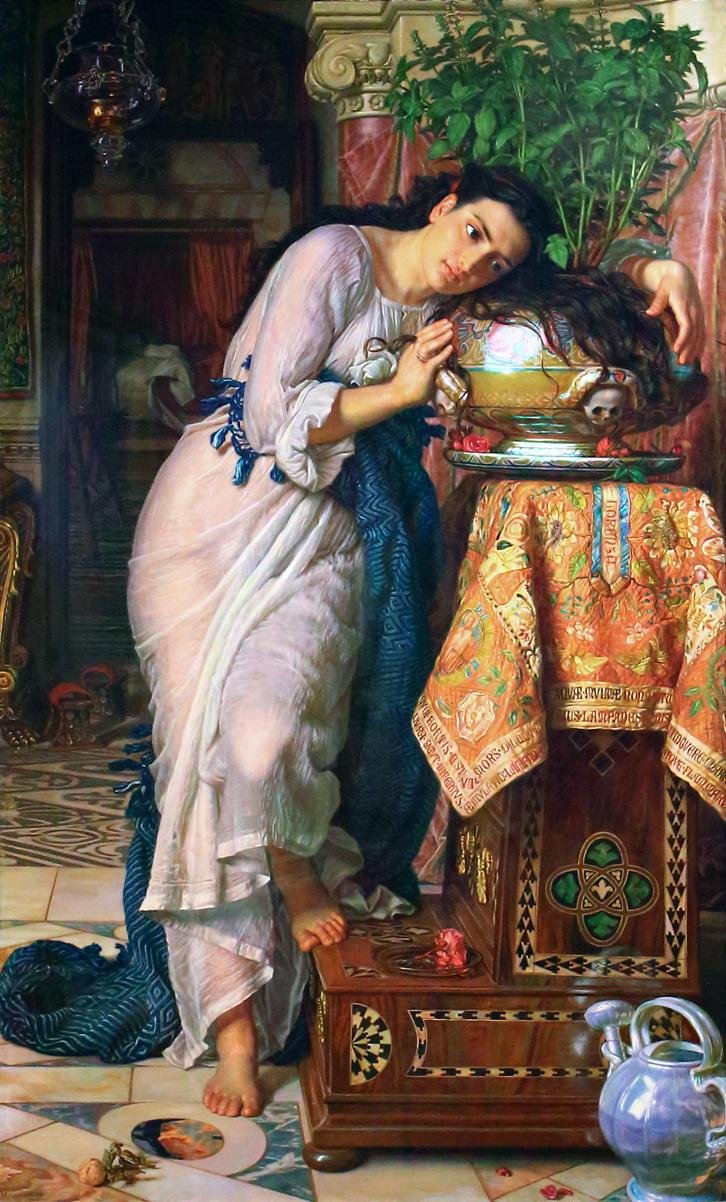The Pot of Basil: A Tale of Love, Betrayal, and Revenge in The Decameron
Introduction
This review examines Boccaccio's fifth tale from the fourth day of The Decameron, the tragic story of Guiscardo and Ghismunda. This analysis will focus on the central themes of passionate love, betrayal, and the devastating consequences of unchecked power, exploring the literary devices employed and the tale's resonance with both 14th-century societal values and contemporary sensibilities.
Summary
Guiscardo, a humble but noble young man, falls deeply in love with Ghismunda, the beautiful and virtuous daughter of Tancred, Prince of Salerno. Their love blossoms despite their differing social standing, and they secretly marry. When Tancred discovers their union, enraged by Guiscardo's audacity and the perceived slight to his authority, he imprisons Guiscardo and has him brutally murdered. Ghismunda, heartbroken and defiant, refuses all offers of marriage from other suitors. Tancred, hoping to break her spirit, presents her with Guiscardo's heart in a golden cup, believing her grief will be so intense it will consume her. Instead, Ghismunda, in a powerful act of defiance and love, drinks the poison she finds within the cup, dying beside her beloved's heart.
Analysis
The central theme of the tale is the destructive power of unchecked authority and the unwavering strength of passionate love in the face of adversity. Tancred, the tyrannical prince, represents the arbitrary exercise of power, his actions driven by pride and a need to maintain control. His cruelty underscores the social inequalities of 14th-century Italy, where a powerful man could easily dispose of those who defied him. Ghismunda's unwavering love for Guiscardo, and her ultimate act of self-sacrifice, becomes a powerful counterpoint to Tancred's brutality. Her defiance is not merely an act of rebellion; it's a testament to the enduring power of love and the rejection of a life without her beloved.
Boccaccio masterfully employs several literary devices to enhance the narrative's impact. The pathos evoked by Ghismunda's grief and ultimate sacrifice is profoundly moving. The irony lies in Tancred's attempt to break Ghismunda's spirit, which instead leads to her heroic and tragic demise. The symbolism of the golden cup containing Guiscardo's heart is potent, representing both the beauty and the poison of love, the preciousness of the relationship and the ultimate cost of defying Tancred's authority. The tale also utilizes vivid imagery to create a sense of both the passionate love between Guiscardo and Ghismunda and the brutal violence inflicted upon them.
The tale reflects the 14th-century preoccupation with courtly love and the power dynamics inherent in feudal society. The story highlights the limited agency women had within such a system, yet also showcases Ghismunda's agency in choosing death over a life without Guiscardo. This resonates today because it explores universal themes of love, loss, and the fight against oppression. While the specific social context may differ, the struggle against tyranny and the enduring power of love remain timeless concerns.
Personal Response
This tale profoundly impacted me. Ghismunda's unwavering loyalty and ultimate sacrifice are both heartbreaking and inspiring. The story's tragic beauty and the stark contrast between Ghismunda's passionate love and Tancred's cold cruelty create a powerful emotional response. The tale's exploration of the destructive nature of unchecked power and the enduring power of love makes it a compelling and unforgettable narrative.
Conclusion
"The Pot of Basil" remains a powerful and relevant story because it explores timeless themes of love, loss, and the struggle against oppression. Ghismunda's story serves as a poignant reminder of the enduring power of love in the face of adversity and the devastating consequences of unchecked power. The tale's enduring appeal lies in its exploration of universal human emotions and its poignant depiction of a love story that transcends the constraints of its historical context.
# The Decameron
#Boccaccio
#Medieval Literature
# Literary Review
Introduction
This review examines Boccaccio's fifth tale from the fourth day of The Decameron, the tragic story of Guiscardo and Ghismunda. This analysis will focus on the central themes of passionate love, betrayal, and the devastating consequences of unchecked power, exploring the literary devices employed and the tale's resonance with both 14th-century societal values and contemporary sensibilities.
Summary
Guiscardo, a humble but noble young man, falls deeply in love with Ghismunda, the beautiful and virtuous daughter of Tancred, Prince of Salerno. Their love blossoms despite their differing social standing, and they secretly marry. When Tancred discovers their union, enraged by Guiscardo's audacity and the perceived slight to his authority, he imprisons Guiscardo and has him brutally murdered. Ghismunda, heartbroken and defiant, refuses all offers of marriage from other suitors. Tancred, hoping to break her spirit, presents her with Guiscardo's heart in a golden cup, believing her grief will be so intense it will consume her. Instead, Ghismunda, in a powerful act of defiance and love, drinks the poison she finds within the cup, dying beside her beloved's heart.
Analysis
The central theme of the tale is the destructive power of unchecked authority and the unwavering strength of passionate love in the face of adversity. Tancred, the tyrannical prince, represents the arbitrary exercise of power, his actions driven by pride and a need to maintain control. His cruelty underscores the social inequalities of 14th-century Italy, where a powerful man could easily dispose of those who defied him. Ghismunda's unwavering love for Guiscardo, and her ultimate act of self-sacrifice, becomes a powerful counterpoint to Tancred's brutality. Her defiance is not merely an act of rebellion; it's a testament to the enduring power of love and the rejection of a life without her beloved.
Boccaccio masterfully employs several literary devices to enhance the narrative's impact. The pathos evoked by Ghismunda's grief and ultimate sacrifice is profoundly moving. The irony lies in Tancred's attempt to break Ghismunda's spirit, which instead leads to her heroic and tragic demise. The symbolism of the golden cup containing Guiscardo's heart is potent, representing both the beauty and the poison of love, the preciousness of the relationship and the ultimate cost of defying Tancred's authority. The tale also utilizes vivid imagery to create a sense of both the passionate love between Guiscardo and Ghismunda and the brutal violence inflicted upon them.
The tale reflects the 14th-century preoccupation with courtly love and the power dynamics inherent in feudal society. The story highlights the limited agency women had within such a system, yet also showcases Ghismunda's agency in choosing death over a life without Guiscardo. This resonates today because it explores universal themes of love, loss, and the fight against oppression. While the specific social context may differ, the struggle against tyranny and the enduring power of love remain timeless concerns.
Personal Response
This tale profoundly impacted me. Ghismunda's unwavering loyalty and ultimate sacrifice are both heartbreaking and inspiring. The story's tragic beauty and the stark contrast between Ghismunda's passionate love and Tancred's cold cruelty create a powerful emotional response. The tale's exploration of the destructive nature of unchecked power and the enduring power of love makes it a compelling and unforgettable narrative.
Conclusion
"The Pot of Basil" remains a powerful and relevant story because it explores timeless themes of love, loss, and the struggle against oppression. Ghismunda's story serves as a poignant reminder of the enduring power of love in the face of adversity and the devastating consequences of unchecked power. The tale's enduring appeal lies in its exploration of universal human emotions and its poignant depiction of a love story that transcends the constraints of its historical context.
# The Decameron
#Boccaccio
#Medieval Literature
# Literary Review
The Pot of Basil: A Tale of Love, Betrayal, and Revenge in The Decameron
Introduction
This review examines Boccaccio's fifth tale from the fourth day of The Decameron, the tragic story of Guiscardo and Ghismunda. This analysis will focus on the central themes of passionate love, betrayal, and the devastating consequences of unchecked power, exploring the literary devices employed and the tale's resonance with both 14th-century societal values and contemporary sensibilities.
Summary
Guiscardo, a humble but noble young man, falls deeply in love with Ghismunda, the beautiful and virtuous daughter of Tancred, Prince of Salerno. Their love blossoms despite their differing social standing, and they secretly marry. When Tancred discovers their union, enraged by Guiscardo's audacity and the perceived slight to his authority, he imprisons Guiscardo and has him brutally murdered. Ghismunda, heartbroken and defiant, refuses all offers of marriage from other suitors. Tancred, hoping to break her spirit, presents her with Guiscardo's heart in a golden cup, believing her grief will be so intense it will consume her. Instead, Ghismunda, in a powerful act of defiance and love, drinks the poison she finds within the cup, dying beside her beloved's heart.
Analysis
The central theme of the tale is the destructive power of unchecked authority and the unwavering strength of passionate love in the face of adversity. Tancred, the tyrannical prince, represents the arbitrary exercise of power, his actions driven by pride and a need to maintain control. His cruelty underscores the social inequalities of 14th-century Italy, where a powerful man could easily dispose of those who defied him. Ghismunda's unwavering love for Guiscardo, and her ultimate act of self-sacrifice, becomes a powerful counterpoint to Tancred's brutality. Her defiance is not merely an act of rebellion; it's a testament to the enduring power of love and the rejection of a life without her beloved.
Boccaccio masterfully employs several literary devices to enhance the narrative's impact. The pathos evoked by Ghismunda's grief and ultimate sacrifice is profoundly moving. The irony lies in Tancred's attempt to break Ghismunda's spirit, which instead leads to her heroic and tragic demise. The symbolism of the golden cup containing Guiscardo's heart is potent, representing both the beauty and the poison of love, the preciousness of the relationship and the ultimate cost of defying Tancred's authority. The tale also utilizes vivid imagery to create a sense of both the passionate love between Guiscardo and Ghismunda and the brutal violence inflicted upon them.
The tale reflects the 14th-century preoccupation with courtly love and the power dynamics inherent in feudal society. The story highlights the limited agency women had within such a system, yet also showcases Ghismunda's agency in choosing death over a life without Guiscardo. This resonates today because it explores universal themes of love, loss, and the fight against oppression. While the specific social context may differ, the struggle against tyranny and the enduring power of love remain timeless concerns.
Personal Response
This tale profoundly impacted me. Ghismunda's unwavering loyalty and ultimate sacrifice are both heartbreaking and inspiring. The story's tragic beauty and the stark contrast between Ghismunda's passionate love and Tancred's cold cruelty create a powerful emotional response. The tale's exploration of the destructive nature of unchecked power and the enduring power of love makes it a compelling and unforgettable narrative.
Conclusion
"The Pot of Basil" remains a powerful and relevant story because it explores timeless themes of love, loss, and the struggle against oppression. Ghismunda's story serves as a poignant reminder of the enduring power of love in the face of adversity and the devastating consequences of unchecked power. The tale's enduring appeal lies in its exploration of universal human emotions and its poignant depiction of a love story that transcends the constraints of its historical context.
# The Decameron
#Boccaccio
#Medieval Literature
# Literary Review
0 Reacties
·0 aandelen
·1K Views
·0 voorbeeld




